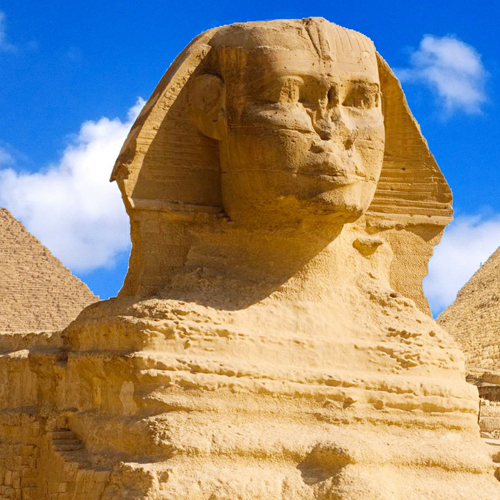No other nation in the world says ‘Welcome’ as often as the Egyptians, and every time, they mean it. While the ancient civilization of Egypt continues to amaze, contemporary Egyptians are equally remarkable.
Giza Travel Guide
In-Depth Guide to the Enchanting Giza Pyramids: A Journey Through Time
As you stand amidst the Giza pyramids, the surreal sensation of traversing through millennia washes over you. These colossal structures, born from the arid sands of Egypt, are not just relics of a bygone era but portals into a world where ancient history coexists with the contemporary skyline of distant city buildings. It’s a juxtaposition of epochs, a dance of time where past and present merge.
The narrative of Giza begins with the Great Pyramid, conceived under the reign of King Khufu during the fourth dynasty. This architectural marvel, the only surviving entity of the Seven Wonders of the Ancient World, held the title of the world’s tallest building until the early 20th century. Known also as Khufu’s Pyramid, it heralded the rise of two other pyramids on the Giza Plateau, turning this locale into a historical epicenter.
Following Khufu, his son Khafre erected his own pyramid, deceitfully appearing taller due to its elevated foundation. This optical illusion is a testament to the ingenuity of ancient architects. King Menkaure, continuing this monumental legacy, commissioned the construction of the third pyramid, albeit smaller in stature.
The construction saga of these pyramids is as captivating as the structures themselves. Workers journeyed across the river from Cairo, braving the relentless sun, to extract white limestone from the Tura quarries. Despite the herculean effort and distance, they successfully transported these stones back to the Giza Plateau. Over time, most of the original casing stones were lost, leaving only those atop Khafre’s pyramid, lending it a smoother appearance.
Embark on an expertly guided tour and unearth the myriad of myths and legends that the Giza pyramids have inspired. From being attributed to the ingenuity of extraterrestrials to theories of Atlantean origin, these structures have sparked endless debates and speculations, especially concerning their construction methods, devoid of modern machinery.
The pyramids are not solitary structures; they form part of a larger complex, including valley temples, causeways, satellite pyramids, and mortuary temples. Despite the ravages of time, the remnants of these ancillary structures offer a glimpse into ancient funerary practices. Notably, the boat pits near Khafre’s and Khufu’s pyramids revealed a significant archaeological find: the oldest known full-length wooden boat, meticulously reconstructed and now housed in a dedicated museum on the southern side of Khufu’s pyramid.
Nearby, the imposing Great Sphinx, with its lion’s body and human head, stands sentinel. Measuring over 20 meters in height and 73 meters in length, it’s a monumental sculpture that has captivated the imagination for centuries. During the New Kingdom, pharaohs like Tuthmose IV erected stelae and temples in its vicinity, including the famous Dream Stela between its paws.
Even today, the Giza Plateau is an active archaeological site, with new discoveries constantly reshaping our understanding of this ancient wonder. The ever-evolving nature of these excavations makes each visit a unique experience.
As a bustling tourist hub, the Giza Plateau is undergoing thoughtful redevelopment to enhance the visitor experience. With a plethora of sites to explore, from the iconic pyramids to the lesser-known mastaba tombs, a journey here can span days, each filled with awe and discovery. The goal is to make this ancient wonder as accessible and enriching for modern travelers as possible, bridging the gap between the ancient and the present, much like the pyramids themselves.
Created On March 18, 2020
Updated On Aug , 2024
GIZA Travel Guide



